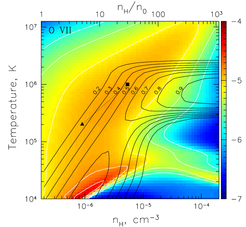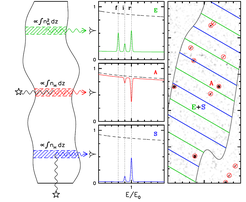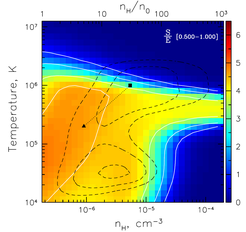X-ray emission from Warm-Hot Intergalactic Medium
The Warm-Hot Intergalactic Medium contributes substantially to the matter budget in the Universe – but it is only poorly studied, as it is very difficult to observe. Researchers at MPA have now predicted how it can be explored using heavier elements as tracers. Due to scattering of the cosmic X-ray background some of this line emission can be boosted substantially and should be accessible by the upcoming X-ray survey missions.

Half of the baryonic budget in the present-day Universe is very well hidden – astronomers believe it can be found in the Warm-Hot Intergalactic Medium, which is as abundant and imperceptible as the nitrogen in the air we breathe. Being produced naturally by the ongoing formation of the largest structures in the Universe, this gas has a temperature between 100,000 and 1 million Kelvin and its density exceeds the mean baryonic density by less than a factor of 100. The high temperature of this gas implies that hydrogen and helium should be almost fully ionized and, as a consequence, it cannot be revealed via the Lyman alpha absorption features in the spectra of background quasars (contrary to the high-redshift intergalactic medium, which is readily detected in this way). It is also difficult to observe this gas directly, since its thermal emission is very faint (due to its low density) and also happens to peak in the observationally-challenging extreme UV/soft X-ray energy range.

Figure 2. Three main signatures (middle) of a layer of the Warm-Hot Intergalactic Medium (left) in X-rays: it is seen in intrinsically produced X-ray emission (E, top), resonant absorption in the spectra of bright background sources (A, middle), and resonant scattering of the isotropic cosmic X-ray background emission (S, bottom).
The spectrum of the intrinsic emission possesses both significant continuum and line emission, with comparable amplitude of the resonant (r), intercombination (i) and forbidden (f) lines. The absorption spectrum is essentially the spectrum of the background source (black dashed line) with imposed resonant absorption lines. The scattered component is dominated by resonantly scattered emission lines of the most abundant ions, with no contribution from forbidden lines.
The right panel illustrates an observing strategy for detecting the scattered component: emission of bright background sources (marked with crossed red circles) should be removed from the aperture. The residual signal will then contain both the unresolved fraction of the cosmic X-ray background and emitted plus scattered radiation from the Warm-Hot Intergalactic Medium.Fortunately, the Warm-Hot Intergalactic Medium is enriched by heavier elements (such as carbon, nitrogen, oxygen, neon and iron) expelled from the star-forming galaxies by powerful galactic-scale outflows (as hinted e.g. by cosmological hydro-simulations, see Fig.1). Having escaped full ionization, atoms of heavy elements produce numerous emission lines and resonant absorption features. For a low density gas, such as the Warm-Hot Intergalactic Medium, the absorption features are particularly important, since their amplitude is proportional to the total number of ions on the line-of-sight, so it scales linearly with the gas number density. While a large amount of observing time has already been invested in searches for the Warm-Hot Intergalactic Medium by this technique (taking advantage of high resolution grating spectrometers on board the Chandra and XMM-Newton X-ray observatories), only marginal detections have been reported so far.
In fact, these absorption features are a result of resonant scattering, which is not a true absorption process by itself. Indeed, the intensity lost in the direction of the bright background sources is compensated by increased intensity in all other directions (see Fig. 2). The net effect of course cancels out after integrating over all directions in the case of an isotropic radiation field, such as the Cosmic X-ray Background. Nonetheless, a large portion of this background is contributed by bright individual sources (mainly Active Galactic Nuclei), which can be resolved and excluded from a given aperture. The remaining signal will then contain both the unresolved part of the background radiation (with similar absorption features as in resolved part) plus the spatially-extended resonantly-scattered background radiation. This emission is heavily dominated by the brightest resonance lines and supplements the intrinsic thermal emission from a slab of Warm-Hot Intergalactic Medium, boosting its overall X-ray emissivity and changing important spectral characteristics such as the equivalent widths of the lines and their respective ratios.

Recently, MPA scientists performed calculations of the X-ray emission from a layer of Warm-Hot Intergalactic Medium that take into account photoionization by the Cosmic X-ray Background and allow self-consistent inclusion of the resonantly scattered line emission (see Fig.3). The overall boost of emission in the most prominent resonant lines (O VII, O VIII and Ne IX) was found to equal ~30, and this boost is pretty much uniform across almost the whole region of the density-temperature diagram relevant for the Warm-Hot Intergalactic Medium. Even after averaging over broader spectral bands, the boost factor remains very significant (~5) but declines steeply at temperatures above T~1 million K (for all considered densities) and at over-densities > 100, as demonstrated in Fig.4 for the 0.5-1 keV band. The predicted total emission in this band is predicted to be dominated by the resonant lines of the helium- and hydrogen-like oxygen, which have comparable intensity for the major part of the explored parameter space.

Figure 4. Ratio of scattered to intrinsic X-ray emission integrated over 0.5-1 keV energy band as a function of number density and temperature of the Warm-Hot Intergalactic Medium. The black dashed contours indicate the ionization fraction of He-like oxygen weighted with the mass and mean metallicity of the corresponding gas portion extracted from the Magneticum simulation snapshot at z~0. The black solid triangle and square connected by a dotted line mark the parameters of typical sheet-like and filament-like structures.
A significant detection of a layer of Warm-Hot Intergalactic Medium (at a redshift ~0.1) in emission might be achieved by an X-ray instrument with an effective area of about 1000 cm^2 (at 0.5-1 keV) with a exposure on the order of 1 million seconds over one square degree of the sky – taking into account contamination by the unresolved cosmic X-ray background and the Galactic diffuse soft X-ray foreground. These requirements might already be met with a single observation by the eROSITA telescope onboard of the forthcoming SRG mission.
Future X-ray missions will indeed provide great opportunities to study the Warm-Hot Intergalactic Medium, both with large-area X-ray surveys and with deep small-area observations with X-ray calorimeters. For the former, the signal can be detected by a cross-correlation of the stacked (absorption and emission) X-ray signal with certain tracers of overdensities in the large-scale structure (e.g. 2MASS galaxies), while for the latter detection (and potentially diagnostics) of prominent individual filaments at z~0.1 is the primary goal.















